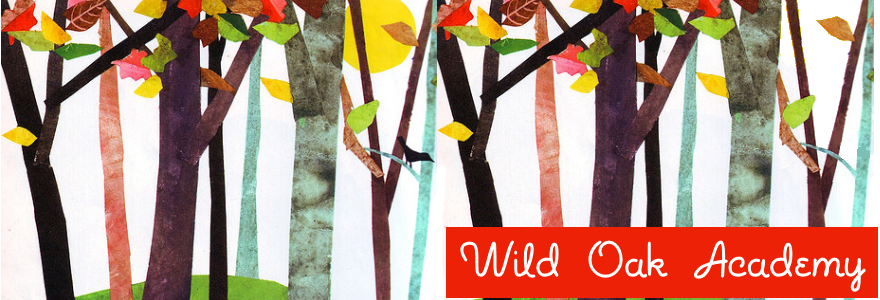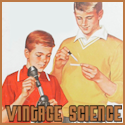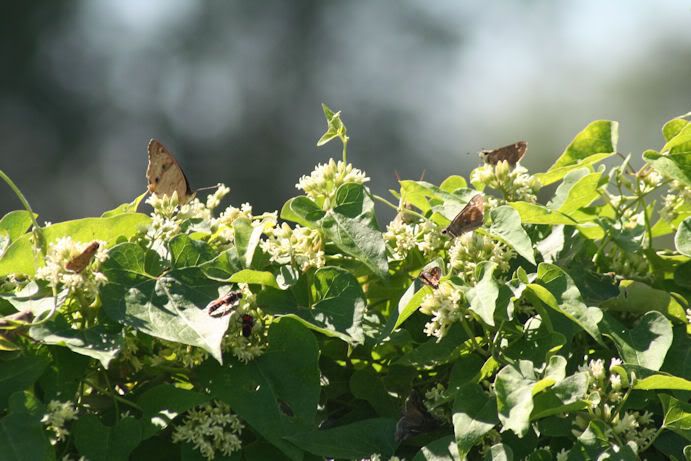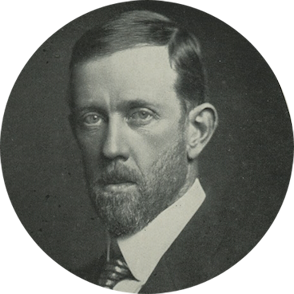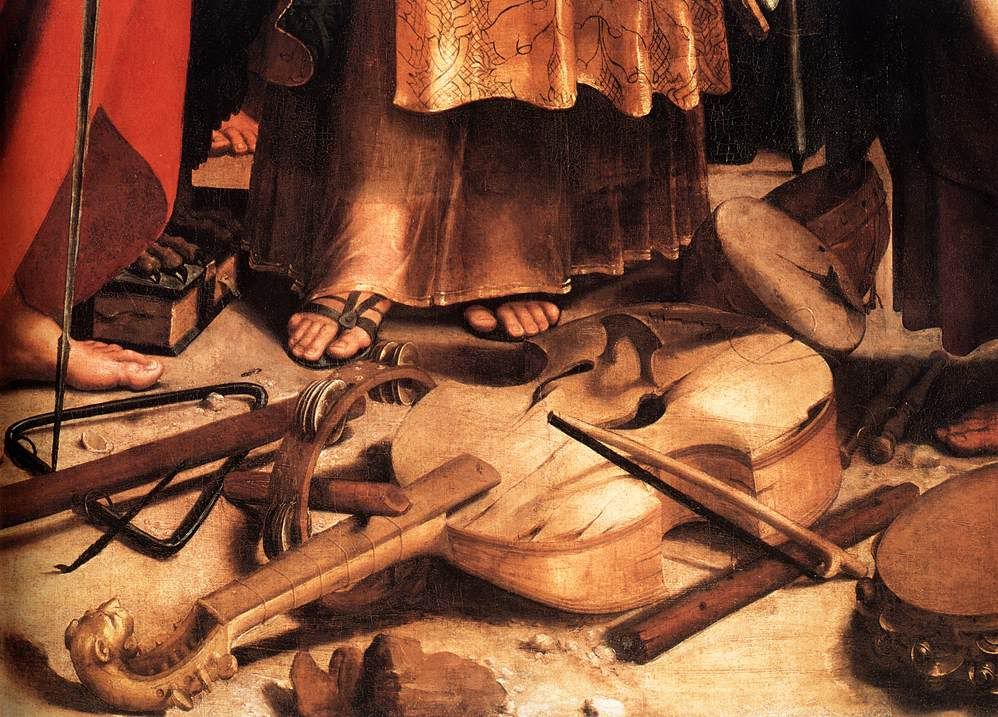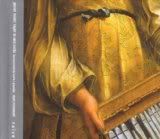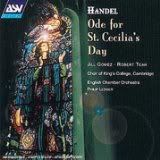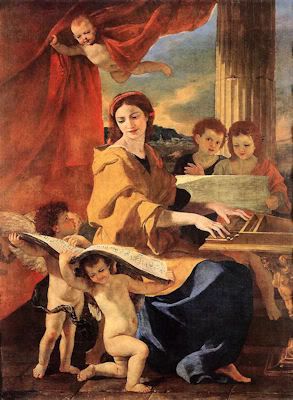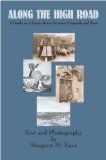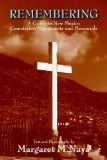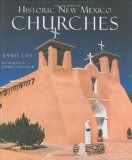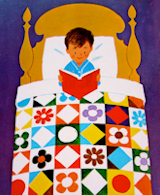
This week marked our second week of the new school year, and clearly, we've still got some issues to work out. Somehow, I had greatly underestimated the amount of time each subject would take now that I have only two students (and very speedy students at that!). As a result, our days have been embarrassingly brief. Granted we are waiting on our Math and Science books to arrive, but even still, the work is going way too quickly. I'm still trying to figure out what we can do differently in the future!
Religion
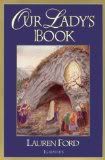
Each day began with a reading from Saints for Young Readers, Vol. 2, followed by lesson work from St. Joseph's Baltimore Catechism No. 2. This week, the kids were responsible for memorizing the last two catechism questions/answers from Lesson 1 (last week they memorized the first five), which included the Apostles' Creed.
- We read (p. 9 - 46) from the beautiful An Illustrated Catechism by Inos Biffi to learn the meaning behind each line of the Apostles' Creed and completed a fill-in-the-blank worksheet on the Creed from 100 Activities Based on the Catechism of the Catholic Church.
- Each morning I read a little from the gem Our Lady's Book by artist/storyteller Lauren Ford. The book tells the story, in words and pictures, of the apparitions of Our Lady at LaSalette, Fatima, Pomain, Lourdes, and Rue de Bac.
- For the Feast of St. Rose of Lima, we had rose-shaped, rose-secented cup cakes and a small rose cake (with the leftover batter) and colored this picture from CHC.
- For the Feast of St. Louis IX, King of France, we read the story Saint and King from Saints and Heroes by Mrs. Lang. We also attempted to make some St. Louis Gooey Butter Cake, which really has nothing to do with the saint (except in name), but is a traditional dessert from St. Louis the city. Unfortunately, the batter didn't rise, so it was a complete loss.
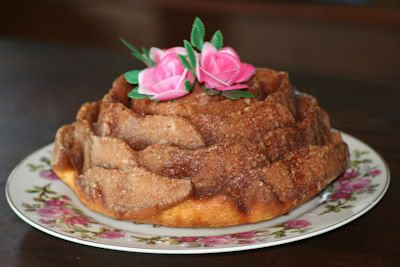


Language Arts
Language arts seems to comprise our central focus this year, though this wasn't intentional. It's also a bit of a mess at the moment (what's new?!). I realized mid-week that my choice for composition wasn't the greatest (it was the first composition book that I'd found on Google Books and is probably too advanced), so I am planning on finding a suitable replacement this weekend.
I love the supplement for teachers, Methods and Material for Composition by Alhambra G. Denning and would like to utilize this somehow, maybe. I wanted something in the style of Primary Language Lessons, but better - I think Vital English (Intermediate text here) may be the solution, but will be exploring this further.
- Handwriting: Two worksheets per day (M-Th).
- Spelling: One lesson per day from Word Power Through Spelling. We love these books, but the words have proven a bit too easy. I may need to bump them up a level or two because they're not being adequately challenged.
- Vocabulary: One lesson per day (M-Th) from Vocabulary 5 for Young Catholics.
- Grammar: One lesson per day from Voyages in English (nouns). These books proved hugely disappointing. We have chosen to ignore the rather uneven lessons at the beginning of the book and instead are strictly doing the grammar exercises in Part 2.
- Composition: Three exercises from A Composition-Grammar. This week's lessons covered: the nature of a sentence, affirmative or negative thought, declarative or interrogative thought, and exclamatory or non-exclamatory thought. Also, the rules for paragraphs and quotation marks, and, oddly enough, "the study of lettering" (this issue of The School Arts Magazine from October, 1919 proved a helpful supplement.)
- Reading: Two lessons from This Is Our Heritage (6th) and These Are Our People (5th), two lessons from Reading 5/6 for Young Catholics, Comprehension Skills and one lesson each from Reading 5/6 for Young Catholics, Thinking Skills.
History is, at the moment, a bit of an experiment. Because I was very late in deciding what we would study this year, I didn't get the necessary texts and supplements figured out in time (and I was broke by the time I had a plan!), so I had to improvise.
Finally I decided that we would wrap up the Middle Ages and start on American history in January. I divided our first semester (18 weeks) into two week "units," created an outline of what needed to be covered, and set about finding resources with the help of my favorite Google Books. Our "spine" is The Story of Old Europe and Young America and proved especially helpful because, at the end of each chapter, it lists suggestions for additional reading (all easily found using Google Books). So, for each unit, I printed the applicable portion from our spine, printed the supplements, and organized everything in my history filing crate. When this was finished, I went back and printed out maps, worksheets, coloring pages, etc. for each unit and filed them in the crate also. Activity ideas were written out on 3 x 5 index cards and dropped into the appropriate files.

At the start of a new two-week unit, the reading goes into one of these 3-prong poly folders (for history, they share the folder, but for other subjects, I've provided each with his own "text"). Each morning I count out the pages to be read and flag them with these handy-dandy Clip-rite clip tabs; they know by now to read from "tab to tab" each day. Supplements go into the folder's pockets, to be completed after reading.
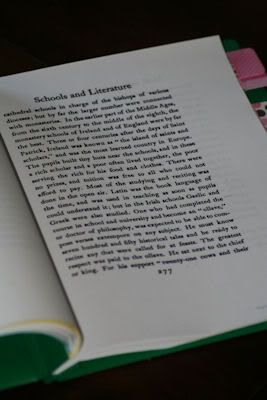
What I love about this system is that it allows me to keep the amount of daily reading fairly even, supplement with the material I choose, costs virtually nothing, and it eliminates the stacks of extra books/supplements we were always scrambling to keep track of. Plus, if I change my mind about a particular supplement (which happens often!), I can switch to something else easily and without guilt.
The first of our history units also proved the most awkwardly put together, since I was picking up from the middle of a chapter in our spine, yet somehow it worked out well enough. We studied the Vikings and also schools, music and literature in the Middle Ages. In addition to our spine, our supplements included stories from Viking Tales by Jennie Hall, European Hero Stories, England's Story, and When Knights Were Bold (my favorite!), all by Eva March Tappan. On average there was 10-15 pages of reading per day. Earlier, I had created some notebooking pages on Vikings, but we never even used them, instead opting for oral narration. We listened to plenty of Medieval music and watched Terry Jones' Medieval Lives: The Minstrel on YouTube. Our read aloud, which we started only this week, was Adam of the Road.
Science
The beautiful weather this week (finally, after a non-existent spring and a long blazing hot summer!) brought us outdoors. Prior to starting the week, I had no immediate plans in place for science. This year we'll be studying Chemistry, but I haven't ordered all of our books yet.
It just so happens that this year we were blessed with the appearance of a mysterious vine (weed), which quickly took over a portion of our back fence. A little research revealed that the vine was called Sand Vine Milkweed, (also, Honeyvine) a very important source of food for Monarchs. Despite warnings about the invasiveness of the vine, I decided to leave it alone since I love how sweetly it smells and don't mind it's appearance in the least. As the summer progressed, it very quickly became the most popular place in our yard for an astonishing variety of winged creatures - from every type of bee imaginable to a dizzying array of butterflies.
This week has been no exception, so at the very last minute, I decided that we would do a brief nature study on butterflies and moths.
Once again, Google Books came to the rescue. I quickly put together a 47-page Nature Reader with relevant stories and information. We've been casually observing the insects all summer long, but now the plan is to have the kids spend a little time formally observing and identifying the butterflies and sketching in their nature journals, followed by some light reading. We will be continuing with this plan next week, so long as the weather holds out. Should I happen to require additional reading, The Insect Folk: Butterflies and Bees (Vol. 2) by Margaret Warner Morley appears to be excellent.
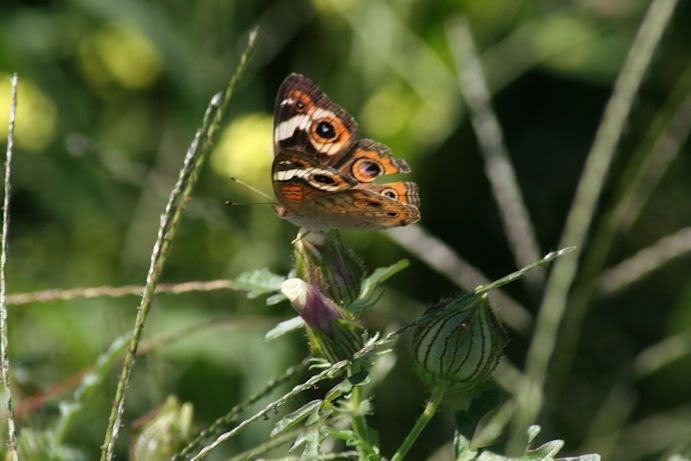
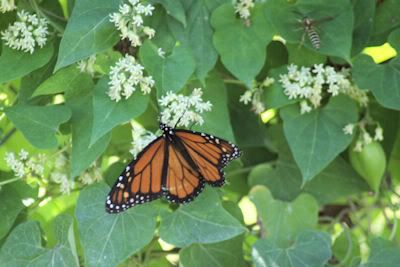
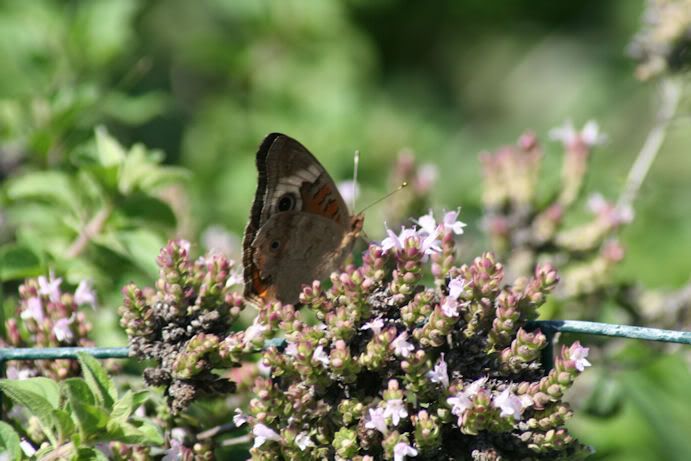
Math
As with everything else, Math was not quite all I'd hoped it would be. Foolishly, all summer long I'd assumed that we had the necessary books for the new school year (I'm certain I ordered them last year!). Since we're using Singapore and it's very, very straightforward, no pre-planning was required. When I discovered, much to my horror, that I did not have the necessary books, I had to come up with a new plan. So, for the past two weeks we've been doing daily math drill worksheets and working on memorization of the multiplication tables through 9 (this was much needed!). Hopefully our Singapore books will arrive next week!
Personal Notes
This has been a quiet week all around. I've been battling some sort of flu/virus all week, so have had zero energy, which never fails to annoy me. Hopefully I'll bounce back this weekend because we have a big busy week ahead!
This week I read A Breath of Air by Rumer Godden, which was a light, enjoyable read. That said, I think I preferred her novel In This House of Brede, which I read last week. I'm eyeing Five for Sorrow, Ten for Joy to read next. I also read Saint Clare: Beyond the Legend by Marco Bartoli (which I'll be reviewing shortly) and re-read The Moonstone by Wilkie Collins.
Labels: Weekly Report
Labels: Gardening, Wordless Wednesday
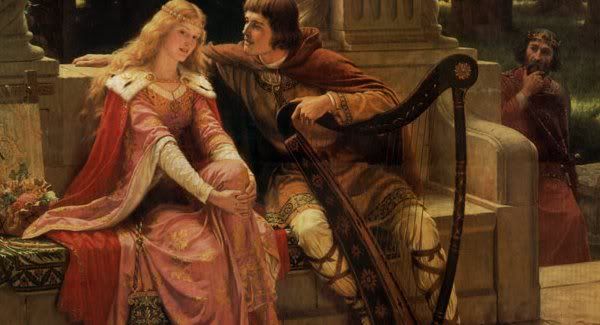
At home people organised their own entertainment, where they might sing local and traditional songs which were accompanied by improvised music. The songs varied from village to village, and related local tales and events. In the early medieval period songs were sung in a simple way (monophony), but later in the medieval period songs became more complicated with a double melody (polyphony). Travelling troubadours and minstrels brought songs and news from village to village, with their accompanying jongleurs and their musical instruments such as the recorder, the shawm and the cittern. These songs were often comic entertainment
The songs often told of love and heroism, sometimes in comedy and sometimes in all seriousness.
The Troubadours
An Overview on Troubadours from Medieval Life and Times
The troubadours were mostly aristocratic poets rather than wandering minstrels or jongleurs and flourished in Provence in southern France from the end of the eleventh to the end of the thirteenth centuries. They composed elaborate lyrics of courtly love which had an extensive influence on Western poetry and culture.
Approximately 2,600 poems and some 260 melodies have been preserved. Some important troubadours were:
The troubadours were mostly aristocratic poets rather than wandering minstrels or jongleurs and flourished in Provence in southern France from the end of the eleventh to the end of the thirteenth centuries. They composed elaborate lyrics of courtly love which had an extensive influence on Western poetry and culture.
Approximately 2,600 poems and some 260 melodies have been preserved. Some important troubadours were:
Marcabru of Gascony, c. 1100 - c.1150
- Song: L'autrier jost'una sebissa (YouTube)
Giraut de Bornelh, c. 1138 – 1215
Guiraut Riquier, c. 1230 - 1300
Bertran de Born, c. 1145 - 1215
The Trouvères
The trouvères flourished in northern France slightly later than the troubadours. Of their poems, 2,130 still exist, and 1,420 of them have been preserved with their melodies. Some important trouvères were:
Conon de Béthune, c. 1160 - 1200- Song: Bien me deüsse targier
- Song: Tant ai amé
- Song: Bele douce dame chiere
- Song: L'amour dont sui espris
- Song: Ma joie me semon
- Song: Onques maiz nus hom ne chanta
- Song: Seignor, sachiez qui or ne s'en ira
- Song: Dame, ensinc est qu'il m'en covient aler
- Song: Pour froidure ne pour yver felon
- Song: Se li maus c'amours envoie
- Song: Tant con je vivrai
- Song: Qui a droit veut amours servir
Minstrels were wandering musicians and entertainers of the Middle Ages, not as refined as the troubadours/trouveres and often of low status (the term "minstrel" means "little servant").
- An Overview on Minstrels (See also: Minstrels)
- VIDEO: Terry Jones' Medieval Lives: The Minstrel (YouTube)
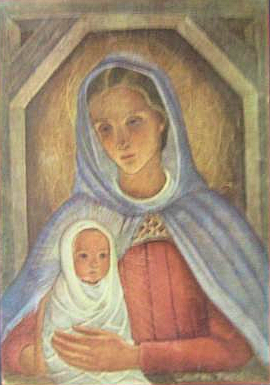
Madonna and Child
From the cover of Life magazine, December 25, 1944 - this was the only color cover of Life during World War II.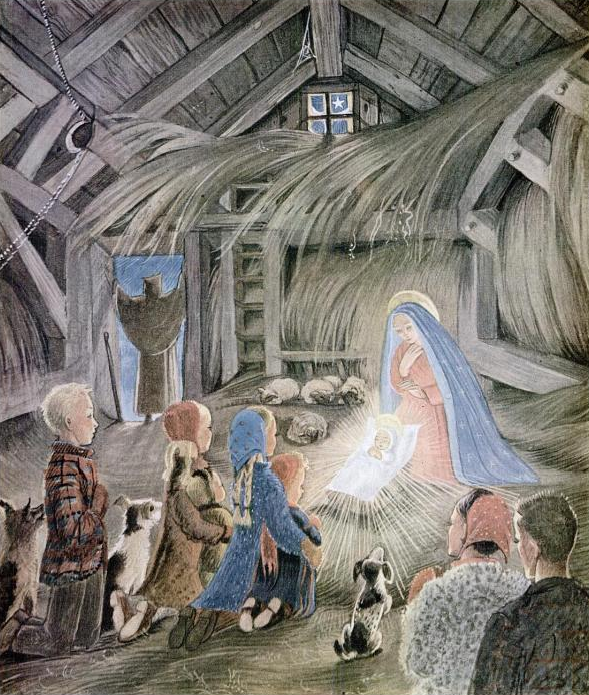
Adoration
Lauren Ford transplants the scene of the Nativity to a barn in Connecticut much like her own. Here she portrays her neighbors gazing in wonder at the Christ Child whose mother had "wrapped Him in swaddling clothes and laid Him in a manger; because there was no room for them in the inn," In the doorway stands St. Joseph awaiting the coming of the the Three Wise Men who are following the star of Bethlehem to where the Christ Child lies.

Resurrection
The day of the Last Judgement when "the dead, small and great" will stand before God is portrayed by Lauren Ford as taking place in the little churchyard of Montguyon in southwestern France. The graves open up and all hwo have been buried there emerge to be judged by Christ in the name of God. On horizon (left) is an old convent building, bought by Miss Ford and a friend and later turned into a refuge for children when Germans invaded France.
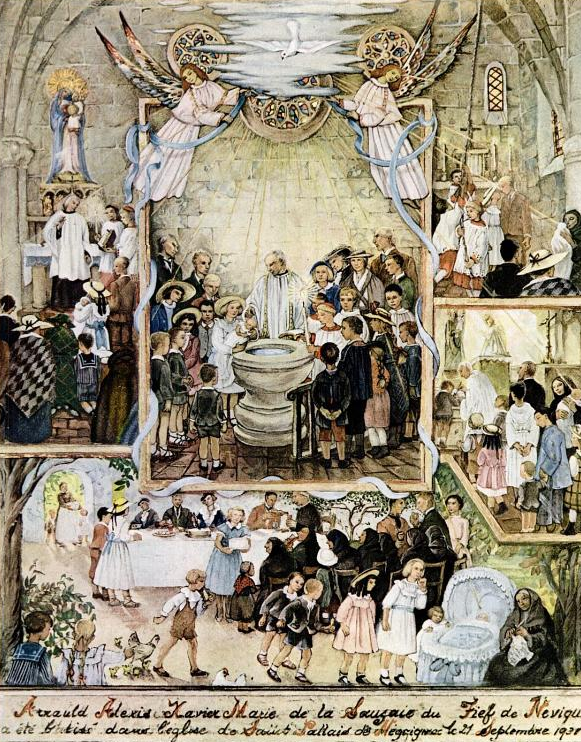
Baptism of Arnauld
While Lauren Ford was living in France, she painted as a momento the story of the baptismal rites of the child of the friends with whom she was staying. In the tradition of religious paintings of the Middle Ages, guardian angels and the dove representing the Holy Spirit hover over the baptismal scene. The baptism took place in the country church of St. Pallais de Negrignac, which Miss Ford has placed on the right horizon in the painting on the opposite page.
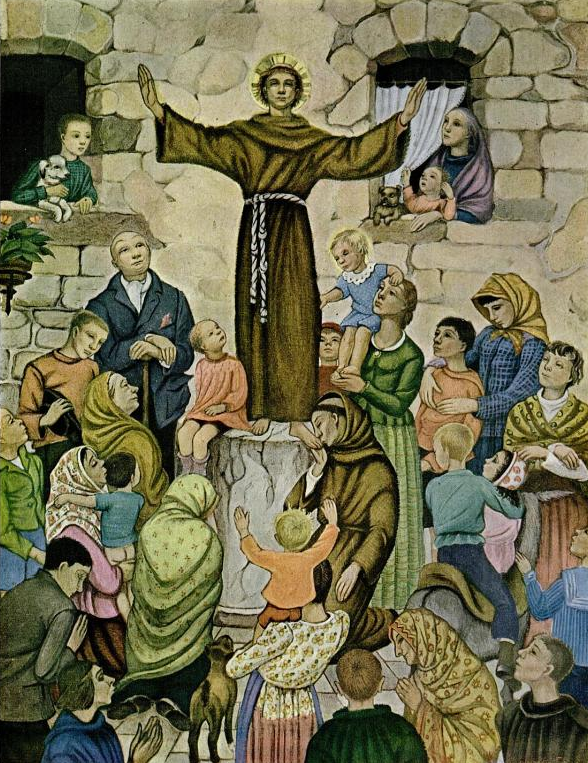
St. Francis
To paint this picture of Christ's devout disciple, Lauren Ford journeyed from France to the hilltown of Assisi in central Italy, the birthplace of St. Francis. There, on one of the little town's narrow cobblestone streets, against the background of ancient Italian architecture, Lauren Ford painted an imaginary scene symbolizing the founding of the Third Order of St. Francis, whose lay followers dedicated themselves to the teachings of humility.
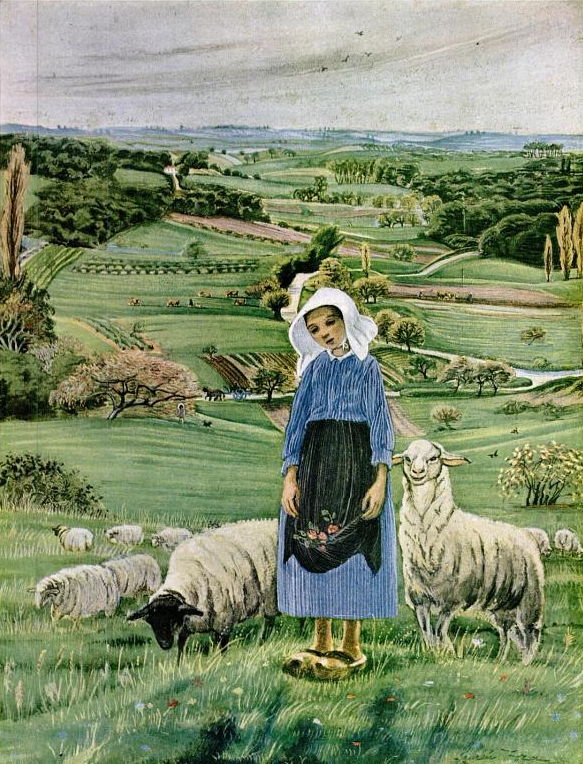
St. Germaine
St. Germaine was the child of a poor farm laborer in southern France who, after her death in 1601, was canonized. Lauren Ford shows her as a shepherdess and tells the story of the day she was accused by neighbors, whose shadows are east in foreground, of stealing food for a starving stranger. At the demand that she show what she has hidden in her apron, Germaine miraculously revealed fresh roses though it was late autumn and roses were not in bloom.
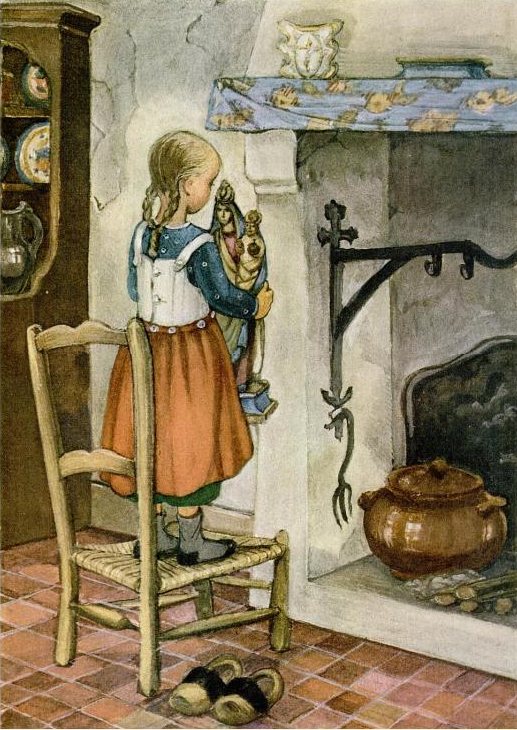
The Celestial Mother
A scene in the childhood of Blessed Catherine Laboure was painted by Lauren Ford. Left motherless, Catherine climbed up on chair and, lifting the statue of the Virgin from the mantel, asked that the Virgin be her adopted mother. Later, as a nun, Catherine predicted France would go through a terrible stress. She died in 1876, leaving a diary which told of miraculous visions, and was beatified in 1933.
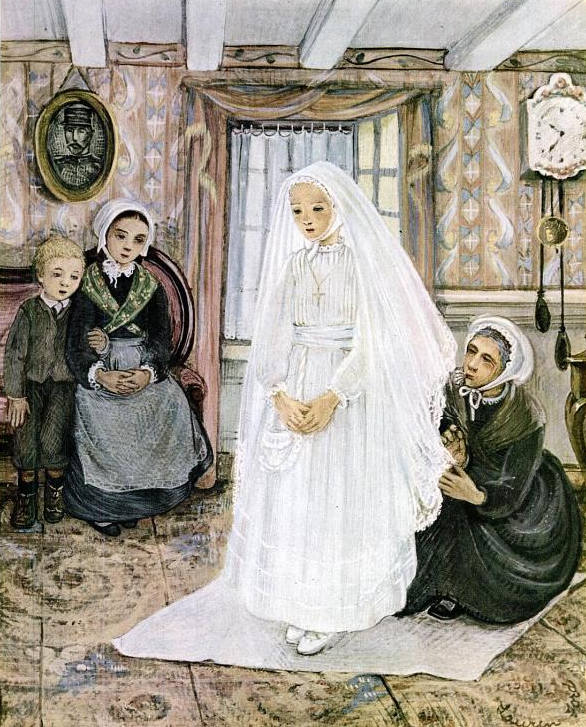
The First Communion Dress
Catherine Laboure is being dressed for her First Communion in the home of her godmother, who is shown with her mouth full of pins, adjusting Catherine's long veil. Watching them in awed silence are Catherine's sister Tonine and brother Auguste. To protect the pristine whitness of the precious dress, which has been handed down from generation to generation, Catherine stands upon a spotless carpet specially spread for this momentous occasion.
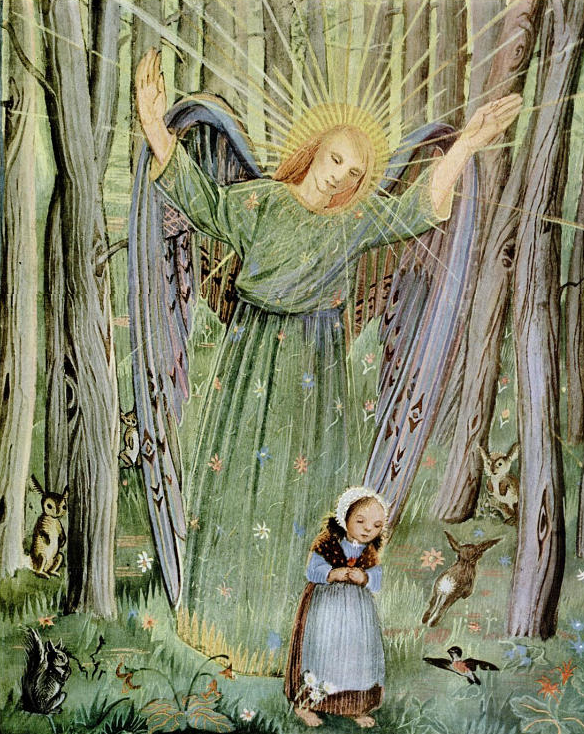
Guardian Angel
The child trudging through the woods protected only by her guardian angel is Melanie de La Salette, who lived 100 years ago in southeastern France. The fifth child of poor peasants, Melanie had an unnaturally brutal mother who sent her out to beg and often tried to lose her in the woods. But Melanie, watched over by her guardian angel, miraculously survived and later, when Melanie's mother grew old, the girl cared for her tenderly until her death.
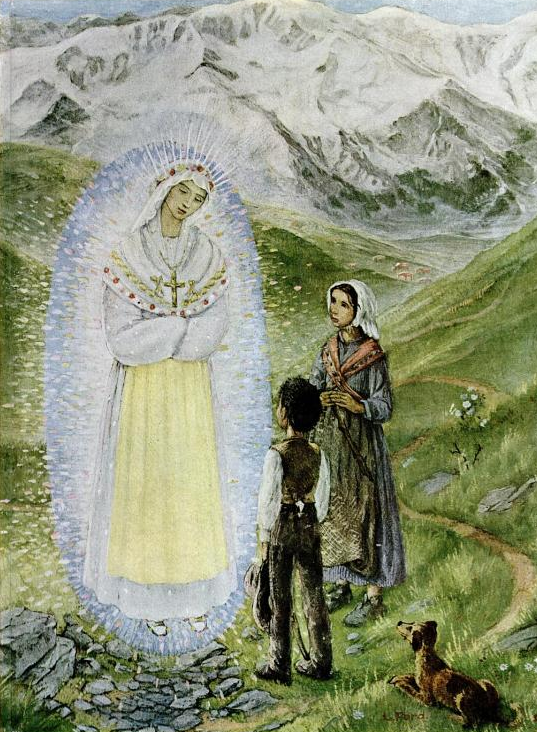
Vision of La Salette
When Melanie de La Salette was 14 the vision of the Virgin appeared to her and her little friend Maxim while they were wandering about in the fields. The Virgin stood before them wearing an apron "the color of light, her gown sewn with pearls that looked like tears." She spoke in perfect French which the children were able to repeat to their elders, though they ordinarily could speak only the dialect of the countryside.
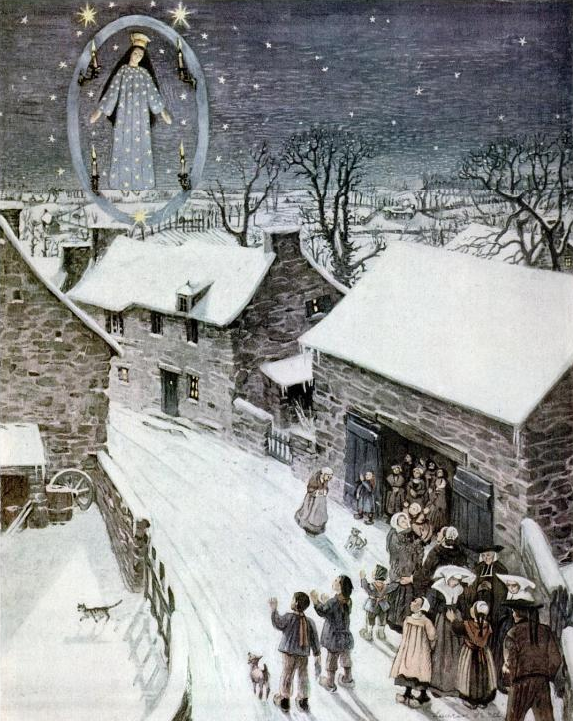
The Vision at Dusk
One evening in 1871 the villagers of Pontmain in Brittany were praying that they be saved from Prussian invaders who were one mile from the town. Suddenly six small children playing in the snow saw in the sky the Virgin appear surrounded by a halo of light. Attracted by the children's exclamations, the older people came running. Since they were grownups, they could see nothing. But within a half hour the Prussians were turned back.
From "A Portfolio of Religious Paintings by Lauren Ford," Life magazine, Dec 25, 1944.
Labels: Authors and Illustrators
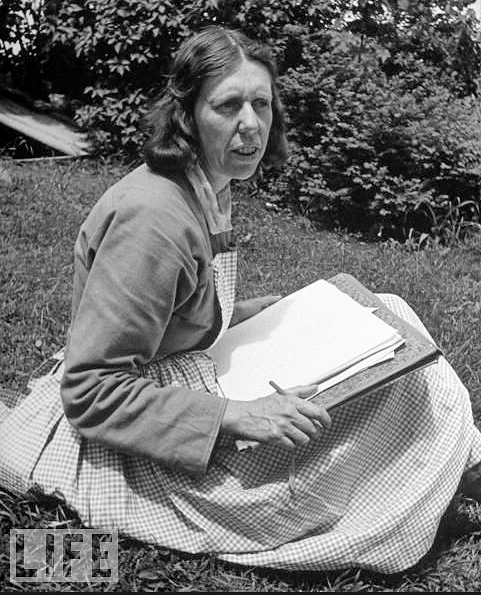
As fellow author Nina Wilcox Putnam described her, "Mrs. Ford collected celebrities as some people collect postage stamps." She was hostess of a twice weekly salon at her New York town house that included notables such as Kahlil Gibran, Ezra Pound, Isadora Duncan, Bertrand Russell, Charlie Chaplin, William Butler Yeats, and Anna May Wong.
"Mrs. Ford had a great interest in the Pre-Raphaelite painters and later artists such as JW Waterhouse and Arthur Hacker, both of whom she knew personally. She went to Germany to meet the German painter Franz von Stuck and to get photographic reproductions of his work. She created her own wallpaper for her upstairs study by arranging on the walls as a mosaic over two hundred photographic reproductions of pictures by these artists." (Source: The Yale University Library Gazette, 1926, via JW Waterhouse)
Lauren’s father was Simeon Ford, son of Backus and Sarah Ford (née Webb). Born on August 31, 1855 in Lafayette, Indiana, he was brought from Indiana to Brooklyn, NY as an infant and was educated in the public schools of Brooklyn and Windham, CT, dropping out at around 15 years of age. He was admitted to the bar in New York in 1876 and practiced law for a short time, later becoming a financier and noted host of the old Grand Union Hotel, New York (co-owned with Julia's brother Samuel Shaw) as well as a published after-dinner speaker.

The Fords married on May 29, 1883 and subsequently bore three children: Ellsworth, born in 1885, Julia Lauren, born in 1890, and Hobart born, in 1894.
Because Lauren's mother wanted her to become an artist and had very definite ideas about education, she was taught to draw when she was only 18 months old. "You have to do things for children when they are very young," she said. At the age of 9, Lauren was sent to Brittany to study painting with her uncle and namesake, Lawrence Shaw, a portrait painter. His instruction, France's medieval art, and the beauty of the liturgy and Gregorian chants of the monks of Solesmes nourished her creative and spiritual growth. She subsequently went on to study at Academie Colarossi in Paris, where she was introduced to the European academic tradition. Later she studied with Frank V. Dumond and George Bridgman at Art Students League in New York. The revival of ecclesiastical art had the greatest influence in her work. Major figures in the movement included her friends Marie Fauconnier, Frances Delehanty, and Justine Ward.
During her life she lived a "simple" and "independent life" on her working farm, named Sheepfold, near Bethlehem, CT, surrounded by family and friends. She received a "continual procession of interesting guests from all over the world." The Connecticut countryside, her neighbors, and her farm animals appear in much of her work. The Nativity Scene is frequently pictured in her own barn. "My painting takes place as simply as washing floors or mending stockings," she said, "all being part of the daily life," and all performed to the glory of God."
After World War II, she was instrumental in the founding of the Abbey of Regina Laudis in Bethlehem, CT (there's a lovely photographic study of the Abbey here). The story of her role in the founding of the Abbey was the basis for the 1949 film starring Loretta Young, "Come to the Stable," and is also discussed in the book, Mother Benedict by Antoinette Bosco. In 1973, Lauren passed away at the age of 82, leaving her estate to the Abbey.
- The Little Book About God (1934)
- Claude: A Tale of an-Idyllic Childhood by Genevieve Fauconnier, Translated and Illustrated by Lauren Ford (1937)
- The Agless Story: With Its Antiphons (1939; beautifully written about here, illustrations shown here)
- Our Lady's Book (1961)
- Lauren Ford's Christmas Book (1963)
- Imagina by Julia Ellsworth Ford, Illustrated by Arthur Rackham and Lauren Ford (1914)
- Memoirs of a Donkey by Madame de Segur (1924)
- Bells of Heaven, The Story of Joan of Arc by Christopher Bick (1949)
- Treasure on the Hill by Marie Lyons Killilea (1960)
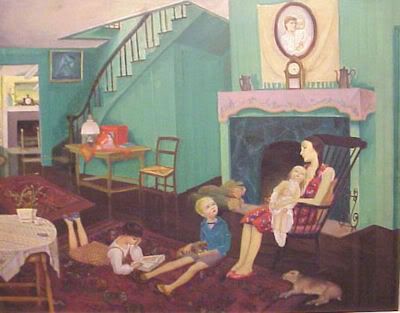
La Grippe (Home Fires)
Labels: Authors and Illustrators
Feast Day: November 22nd

St. Cecilia by Simon Vouet

St. Cecilia by Simon Vouet
Patroness of Music
More than seventeen hundred years ago there lived a little girl whose name was Cecilia. This little girl is now remembered, the world over, for her goodness and her love of music.
Cecilia's mother and father were Roman nobles. They had a beautiful palace in one of the most pleasant parts of Rome. There, in the midst of all that was rich and grand, the child Cecilia was born.
As she grew up, this gentle maiden cared but little for the wealth and grandeur around her. She loved God, and in everything she did she tried to please Him. She sang sweetly and at a very early age made hymns of her own.
She sang these songs to our dear Lord, Jesus Christ. She loved Him so much that she used to carry the story of His life in the folds of her dress so that she might read of Him at any time. Her voice was so sweet that, when she sang, the angels came to listen.
She learned also to play upon the organ, that thus through music she might further show her love for God. She played with so much skill that to this day she is often called the first of organists.
At that time the rulers of Rome did not believe in Christ. They were very cruel to Christians and wished to drive all of them from the city.
For this reason they put to death some of Cecilia's dearest friends and threw others into prison. At last she too was taken and made to stand up before one of the rulers.
"What is your name?" he asked.
"Christian is my name," she said, "though I am commonly called Cecilia."
" What gods do you serve? "
" I serve Jesus Christ," was the answer.
Then she was led forth to her death; but she went bravely and without fear, knowing that her Lord was with her.
(From Standard Catholic Readers By Grade, Third Year by Mary Doyle)
Resources
- Who Is St. Cecilia? A beautiful biography from the Dominic Sisters of St. Cecilia
- St. Cecilia Prayers, Hymn and Biography from Via Rosa
- St. Cecilia Biography ~ Holy Spirit Interactive Kids
- St. Cecilia Coloring Page at CHC
- St. Cecilia: Saint of the Catacombs Coloring Book at By Way of the Family
- Nameday Ideas for the Feast of St. Cecilia at Catholic Culture
- Recipe: Cécilias
- Recipe: Pettole (Traditional Italian fritters for St. Cecilia's Day)
- Recipe: St. Cecilia Punch (for adults!)
- Recipe: Bread Pudding with St. Cecilia Sauce
Labels: Autumn, Liturgical Year
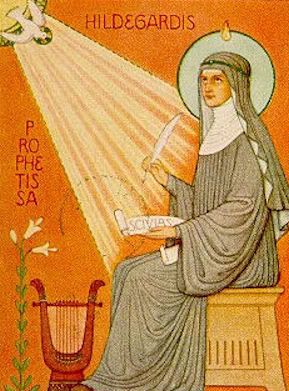
Feast Day: September 17th
Hildegard von Bingen (1098-1179) was a most extraordinary woman: Benedictine abbess, scholar, counselor, visionary, herbalist, healer, dietician, naturalist, poet, artist, composer and lyricist. She is the first saint I read about in-depth when initially exploring Catholicism and I have been fascinated by her ever since.
For her feast day I have compiled the following ideas:
Reading:

For her feast day I have compiled the following ideas:
Reading:
- Children's Biography: Hildegard of Bingen: Woman of Vision by Carol Reed-Jones (88 pgs; Preview here)
- A short biography of Hildegard can also be found in Chapter 6 of Outrageous Women of the Middle Ages
- For adults, I highly recommend Hildegard of Bingen: The Woman of Her Age by Fiona Maddocks and/or Hildegard of Bingen: A Spiritual Reader by Carmen Acevedo Butcher
- Recipe: St. Hildegard's Cookies of Joy ("Eat them often," she said, "and they will calm every bitterness of heart and mind - and your hearing and senses will open. Your mind will be joyous, and your senses purified, and harmful humours will diminish...")
- Cookbook: From Saint Hildegard's Kitchen: Foods of Health, Foods of Joy by Jany Fournier-Rosset (Sample recipes here)
- Tea: Hildegard Blends
In addition to the above reading and food/drink, we will be listening to some of her music -- numerous CDs are available and there is much of it on YouTube also. I especially like The Origin of Fire: Music and Visions of Hildegard von Bingen, a CD by Anonymous 4.
I had dearly hoped that the DVD of Margarethe von Trotta's Vision: From the Life of Hildegard von Bingen would be available in the U.S. this year, but alas, it appears that the film is due for another round in select theaters first (though of course, none in Kansas).
Lastly, we will be making a simple herbal salve from our Herbal Medicine Making Kit, though I think any sort of herbal craft would work equally well. For more on Hildegard as an herbal healer see: Hildegard of Bingen: Herbal Healer of the Rhine, an article from The Herb Companion magazine.

Labels: Liturgical Year
Every now and then, I find myself gripped by an idea, an obsession, that I must thoroughly research and plan out before I am able to let go of it. This road trip is just one such example.
Several days ago, I awoke from a nap thinking that we needed to go on a trip soon; immediately, I began to consider where we should go. Since I've been working on our Day of the Dead and Our Lady of Guadalupe feast day plans, my first thought was Mexico! But of course, we can't realistically drive to Mexico for a few days, so in the end, I settled on New Mexico.
Now, I've got the complete trip planned - a trip which may or may not actually happen, though I'm thinking it probably will, and very soon. I've driven through New Mexico countless times, but I've never really seen the state, so it all seems quite new and exciting.
Day one will be driving, driving, and more driving (for 9+ hours). Our first stop in New Mexico will be the once notorious old mining town Cimarron, followed by Elizabethtown, a gold rush ghost town established in 1867, but largely abandoned by the 1920s. Today the town is slowly being restored by one of its descendants and boasts a rebuilt church, a museum, and nice old cemetery.
Elizabethtown Cemetery © jwoodphoto
I've always had a passion for old cemeteries, but this post and this by artist Laurie Beth Zuckerman has me especially eager to explore New Mexico's cemeteries!
From Elizabethtown, we'll drive another hour to Taos where we'll spend the night.
The High Road/Taos
Day two will begin in gorgeous Taos. In the morning, we'll visit the Hacienda de los Martinez Museum, followed by the San Francisco de Asis Mission Church, an adobe church built between 1772 and 1816, and the most photographed and painted church in Taos. We'll spend a bit of time exploring the shops located around the historic Ranchos de Taos plaza before moving on to the tiny chapel, Nuestra Senora de San Juan de los Lagos del Rio Chiquito (Our Lady of Saint John of the Lakes) in Talpa.
From there, we will drive about 30 minutes through the Carson National Forest to the Picurís Pueblo at Peñasco, home to another beautiful church: San Lorenzo de Picuris. Next up will be Las Trampas where we will visit the old mission church, San Jose de Gracia, which is still an active parish. After Las Trampas, we will head to Nuestra Senora del Rosario, built in the early 1800s and home to many well-preserved old santos. This will be followed by the much-anticipated Chimayó.
In Chimayó, a small community nestled in the Sangre de Cristo mountains, we will visit the Santo Niño Chapel and Santuario de Chimayó, an important pilgrimage site often called the "Lourdes of America." I will also want to stop at the El Potrero Trading Post (aka 'The Vigil Store') for some light shopping. Leaving Chimayó, we will briefly visit Iglesia de la Santa Cruz de la Cañada (church), on our way to the ancient Puye Cliff Dwellings.
Santuario de Chimayó © Alida's Photos
Required Reading:
Santa Fe
After staying overnight in Española, on day three we will drive into Santa Fe (roughly 30 minutes away).
Our first stop of the day will be the amazing Jackalope, which promises to be paradise for me. Here's what one reviewer had to say: "If you are headed to Santa Fe for a visit, plan on spending several hours at Jackalope Imports on Cerrillos Road. Don't pass this up. A couple of acres and several buildings of imported stuff. Fun stuff! Interesting stuff! Colorful stuff! Mostly from Mexico & South America, but if it's unique and colorful they probably have it. Lots of large pots for your garden and city deck. They even have a prairie dog village (yes, with real prairie dogs!) on the grounds." Fun! I plan to budget accordingly and pick up our Day of the Dead and 'Fiesta de la Virgen de Guadalupe' supplies here.
After Jackalope, we have a busy afternoon in Santa Fe planned. As time allows, I would like to visit the following:
- Santuario de Guadalupe (The Chapel of Our Lady of Guadalupe): Built in 1795, it is thought to be the oldest extant shrine to the Virgin of Guadalupe in the United States.
- The Cathedral Basilica of Saint Francis of Assisi: A Romanesque style cathedral built in 1869, includes the La Conquistadora Chapel which houses a 1626 statue of Our Lady of the Rosary
- Mission San Miguel: Built in 1610 by the Tlaxcalan Indians of Mexico, the chapel is one of the oldest standing churches in the U.S. that is still in use today.
- Loretto Chapel: Home of the mysterious Miraculous Staircase, which legend says was constructed or inspired by St. Joseph the Carpenter. It took at least six months to build, and has two 360 degree turns with no visible means of support.
- Rosario Cemetery
- Palace of the Governors: Built in 1610 as Spain's seat of government for what is today the American Southwest, the Palace of the Governors is one of the nation's oldest public structures. Today it serves as a regional historical museum.
- El Rancho de las Golondrinas: A living history museum dedicated to the heritage and culture of Spanish Colonial New Mexico.
A few fun facts about Santa Fe: "Santa Fe" means "Holy Faith" in Spanish. The city was originally occupied by Pueblo Indian villages during 1050 to 1150. Spanish colonists founded the city sometime between 1607 and 1610, making it one of the oldest cities in the country. Santa Fe, a haven for artists, boasts more than 300 art galleries and dealers. At nearly 7,000 feet, Santa Fe has the highest elevation of all the state capitals in the country. (Source)
Santuario de Guadalupe © jwood
The Turquoise TrailDay four will be a bit rushed since we'll need to head home on this day. However, there are a few "quick" stops I'd like to make first. The first stop will be the small yet beautiful old mining town, Los Cerrillos, situated along the historic Turquoise Trail. There we will visit the Casa Grande Trading Post (which includes a fabulously eclectic Turquoise Mining Museum) and the church, Iglesia San Jose, perhaps followed by the Cerrillos Hills Historic Park just north of town.
After Los Cerrillos, we will briefly visit Galisteo where there appears to be a church with a fabulous cemetery and a few other places of interest. The next stop doesn't appear on any maps, but looks exquisite - the church at Canoncito at Apache Canyon, former site of an old trading point. Following this, we may spend an hour or so at Pecos National Historic Park before heading home.
Church at Canoncito at Apache Canyon © Joel Wigelsworth
There are, of course, many many wonderful things that we will not have time to see on this quick little trip, and likewise, a few surprises that I have not mentioned here. I think it promises to be a wonderful adventure!
Labels: Field Trips, Life
Subscribe to:
Posts (Atom)
